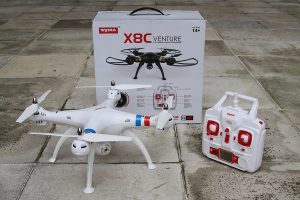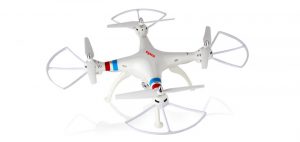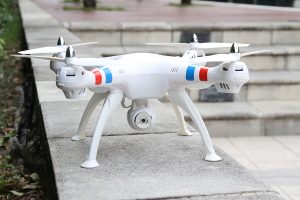The Syma X8C is a 350mm-size toy-grade quadcopter and is currently the largest produced by the Guangdong-based company Syma. With physical dimensions that are almost indistinguishable to the latest Phantom 3, the X8C shares a striking resemblance with DJI’s highly popular range of consumer drones. It even comes with propellers that are similar in size and pitch to the Phantom 3’s. The similarities, however, stop there since the X8C was designed purely as a toy-grade quadcopter that is aimed at beginners who are looking for a more basic and affordable solution to premium consumer drones.
Priced at slightly below $100, the X8C is certainly not in the same ballpark as the Phantom 3 or Walkera’s latest X350 Premium both of which offer more advanced features such as GPS, brushless motors and camera gimbals and can cost well beyond $1000. What makes the X8C so affordable is its use of brushed motors, a fixed camera gimbal and a very basic flight controller that offers no GPS feature. Despite such entry-level features, the X8C is actually quite well built as with many other Syma products such as the highly popular X5C.

The X8C comes with a well-designed body that features an enclosed battery compartment, enclosed motors and gears and down-facing LED lights to help in orientation. The battery compartment is spacious and houses a 2000mAh battery. However, the long battery connector wires can make for quite a tight fit and care should be taken when handling them to avoid damage that could be caused when these wires are folded too tightly.
Specifications
- Dimensions: 50 x 50 x 19cm (with prop guards)
- Diagonal motor distance: 350mm
- Motor size: 15mm coreless
- Weight: Approx 612g (with battery, camera and prop guards)
- Flight time: 10 to 12 minutes
- Battery: 7.4V 2000mAh 25C Li Po
- Charging time: 200 minutes
- Control distance: approximately 100m
- Transmitter power: 4 x 1.5V AA batteries (not included)

Flight Performance
Despite being marketed as an entirely new model on its own, the X8C is actually very much like a super-sized version of the Syma X5C with “headless” mode. This is particularly true with its flight performance and transmitter where the X8C displays similar characteristics to the X5C.
Like the X5C, it is remarkably stable and easy to fly. Hovering is very easy and the X8C responds well to any input from the transmitter with little hesitation. It is also a lot more quiet compared to other quadcopters in the same size category.
Where the X8C really excels over the X5C is its stability in the wind. Thanks to its much larger size and weight, the X8C is less likely to get flipped around in moderate winds that would put the X5C in a dramatic struggle to hold its position. This stability makes the X8C a better choice when it comes to aerial photography.
At the heart of the X8C’s propulsion are some really large coreless motors (measuring approximately 15mm each) paired to 9-inch propellers that provide some serious amount of thrust. This allows the quad to zip around gracefully in the air even in light to moderate winds.
The X8C has so much reserve power that some owners have resorted to mounting GoPro cameras on their X8Cs although this is something that I wouldn’t recommend unless you’re willing to replace those coreless motors sooner than expected. This is because action cameras such as the GoPro or SJ4000 can put a heavy weight penalty on the X8C’s motors that can shorten their lifespan significantly.
However, if you absolutely cannot live without mounting a GoPro on your X8C, then make sure to always keep at least 1 pair of spare motors on standby. They’re very affordable considering each pair costs only $10.
Although equipped with some really powerful motors, the X8C seems to have a rather sluggish yaw rate. This, however, isn’t a real issue since the quad was designed to be more of a low budget aerial photography platform than a high speed racer.
One feature that many beginners would surely find useful is the “Headless” mode — a feature which allows you to fly the quad without worrying where its front is facing. When headless mode is turned on, the X8C will fly in any direction you order it relative to your transmitter’s position, irrespective of where its front or “head” is facing. So if your quad has its front facing right at you, it will move to the left if you push your right control stick to the left.
Headless mode is a great feature to have when you lose orientation of your quad, especially when it is flying some distance away.
Surprisingly, Syma has decided to include the usual aerial stunts (360 degree flips) with this new quad despite its hefty weight and size. Personally, I feel that built-in flips should only be included in toy-grade quadcopters with a size of 250mm and less. Including aerial stunts in anything larger than 250mm such as the X8C can mean some truly dramatic and scary flips.
Due to its weight and size, a lot of room is required for the X8C to perform a flip. Flipping the quad indoors in tight and constrained space is certainly not a good idea considering the amount of damage it can cause when it crashes.
Camera
Despite not having a brushless camera gimbal or any sort of vibration dampening for its camera, the X8C can still take reasonably good videos when conditions are ideal. Its video quality cannot be compared with better aerial photography drones such as the Phantom 3 or Yuneec Q500 but is still fun to watch and impressive for a toy-grade quadcopter.
The weakest link in the X8C, however, is its 2MP HD camera which probably uses the same sensor and electronics as the X5C’s camera. The only difference is its egg-shaped casing which gives it a rather imposing look. As a toy-grade camera, the supplied camera doesn’t disappoint, providing reasonably good videos and images. But for the X8C range, which is supposed to be Syma’s flagship range of toy-grade quadcopters, I’d expect the camera to be slightly better than what’s offered on the lower X5 range.
I guess Syma was probably motivated to keep the X8C’s price as low as possible by reusing the X5C’s camera and giving it a bigger redesigned casing.
The X8C’s camera is attached to it via a fixed gimbal that allows you to adjust the camera’s angle. Attaching or removing the camera is as simple as sliding the gimbal in and out. A small 3.5mm earphone jack is used as a signal connector from the camera to the quad. Images and videos are recorded on a supplied 4GB micro SD card that is inserted into the rear of the camera.
For those looking for better image quality, the X8C has enough thrust to lift GoPro or Mobius action cameras. Since these cameras are a lot heavier than the supplied camera, they will put more stress on the coreless motors and shorten their lifespan so keeping a few of these motors in stock is a good idea.
Transmitter
I’ve never been a fan of Syma transmitters, particularly the way they look. Syma transmitters do work fine but often come in designs that look awkwardly retro. The X8C’s transmitter is no exception to this and echos Syma’s 1980’s sci-fi movie approach to styling transmitters.
As mentioned earlier, the X8C’s 4-channel transmitter is essentially a scaled-up version of the X5C’s in a redesigned body that comes in a funky white and orange color scheme. It is powered by 4AA batteries (despite having 6 battery slots, with 2 being disabled) and features a small LCD display at the bottom that shows you important information such as battery level, throttle position, signal reception, etc.
The transmitter also allows you to toggle between 2 speed modes — High and Low. High, as the name suggests, unleashes the quad’s fullest potential and allows it to fly around at faster speeds.
Conclusion
Overall, the Syma X8C is a wonderful option for those who want a large toy-grade quadcopter that also doubles as an entry-level aerial photography platform. Its biggest selling point is its ability to carry action cameras such as the GoPro or Mobius at an unbeatable price of approximately $100.
With a size of 350mm, the X8C is undoubtedly more stable in the wind when compared to smaller toy-grade quadcopters. This stability can provide for better aerial videos and images.
If you’re not into aerial photography, the X8C is still great fun to fly thanks to its powerful 15mm coreless motors and 2000mAh 2-cell battery. It is highly responsive and stable in the air and becomes even more so with its camera and prop guards removed.

There are, however, some minor drawbacks in the X8C with the most obvious one being its uninspiring 2MP camera that was clearly brought over from the older X5C. Then there is the under-powered stock charger that takes forever to charge the supplied 7.4V 2000mAh battery.
Despite these minor flaws, the X8C is still a great package for those looking to get acquainted with aerial photography but are unwilling to splash $1000 on a Phantom 3. It is also an excellent flyer for those looking to just have some fun flying a quadcopter around and also for those looking for a trainer drone that closely resembles their more expensive 350mm-size drones.